In modern factories, robotic arms precisely grasp components, AGV trolleys shuttle along predetermined routes, and sensors collect real-time operational data from equipment. These seemingly independent industrial devices are, in fact, tightly connected through an invisible "network," with the industrial switch serving as the core hub of this network. It acts as the communication lifeline in industrial settings, enabling efficient and stable data flow between devices.
Many people, upon first hearing about industrial switches, may instinctively assume they are simply upgraded versions of commercial switches for industrial environments. However, in reality, industrial switches are communication devices specifically tailored for industrial scenarios, fundamentally differing from commercial switches in terms of design philosophy and performance metrics.
While commercial switches operate quietly in climate-controlled server rooms, industrial switches endure vastly different survival tests: in coal mine tunnels in Northern Europe, they withstand temperatures as low as -40°C and the dual erosion of coal dust; in chemical parks in Indonesia, they resist temperatures up to 85°C and chemical attacks from corrosive gases; at substations on the Qinghai-Tibet Plateau, they maintain stable communication at an altitude of 4,500 meters. These scenarios reveal a crucial fact: industrial switches are not merely reinforced versions of commercial devices but are redesigned communication hubs for industrial settings.
An industrial switch is a network communication device specifically designed for industrial environments, facilitating efficient and reliable data transmission between devices in industrial automation systems and the Industrial Internet of Things (IIoT).
Commercial switches are typically housed in temperature-controlled, humidity-regulated, and dust-free server rooms, enjoying relatively comfortable working conditions. In contrast, industrial switches face extreme "ice-and-fire" tests.
In the frigid cold of Northern Europe, where temperatures can plummet to -40°C, ordinary equipment would fail due to the cold, but industrial switches continue to operate stably thanks to special low-temperature materials and heating devices. In the scorching heat of steel mills, where ambient temperatures reach 85°C, industrial switches ensure internal circuits remain unaffected through efficient heat dissipation designs and high-temperature-resistant components.
Additionally, they must cope with harsh conditions such as dust, humidity, and corrosive gases, with protection ratings generally exceeding IP40 and some high-end models even reaching IP67, meaning they can completely block dust ingress and withstand short-term immersion without damage.
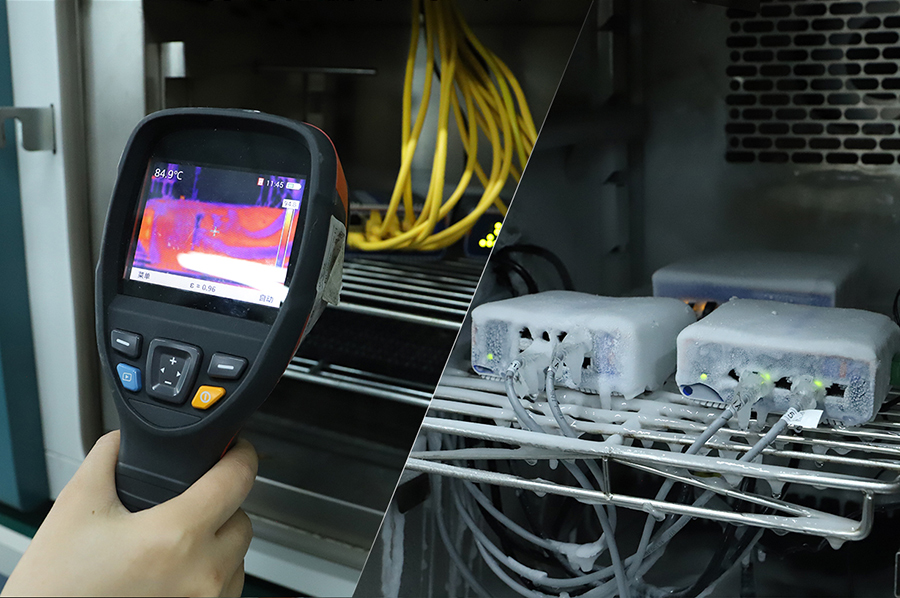
In industrial production, communication interruptions can lead to severe safety accidents and production losses. Therefore, industrial switches demand near-uncompromising reliability.
● They employ dual power redundancy designs, where backup power sources seamlessly switch in when the primary power fails, ensuring continuous device operation.According to statistics, the mean time between failures (MTBF) of industrial switches exceeds 10 years, more than three times that of commercial devices.
Many industrial production processes demand extremely high time precision, such as robotic collaborative operations and motion control. Industrial switches utilize Time-Sensitive Networking (TSN) technology to control end-to-end latency at the microsecond level, ensuring priority and timely transmission of critical data. For example, in automobile manufacturing, during body welding, multiple welding robots must act simultaneously. If data transmission is delayed, it can lead to welding position deviations, affecting body quality.
The real-time performance guarantees of industrial switches enable robotic action synchronization accuracy within ±100μs, significantly improving production efficiency and product quality.
Industrial switches owe their pivotal role in industrial scenarios to a series of core technological supports.
In industrial networks, link failures are a common issue. Industrial switches employ ring redundancy protocols, such as Parallel Redundancy Protocol (PRP) and High-Availability Seamless Redundancy (HSR), to complete link failure switching within 50ms. This means that when a communication link fails, industrial switches can swiftly switch the data transmission path to a backup link, with minimal impact on the normal operation of devices.
In contrast, commercial switches typically require over 30 seconds to complete failure switching, which is unacceptable in industrial production.
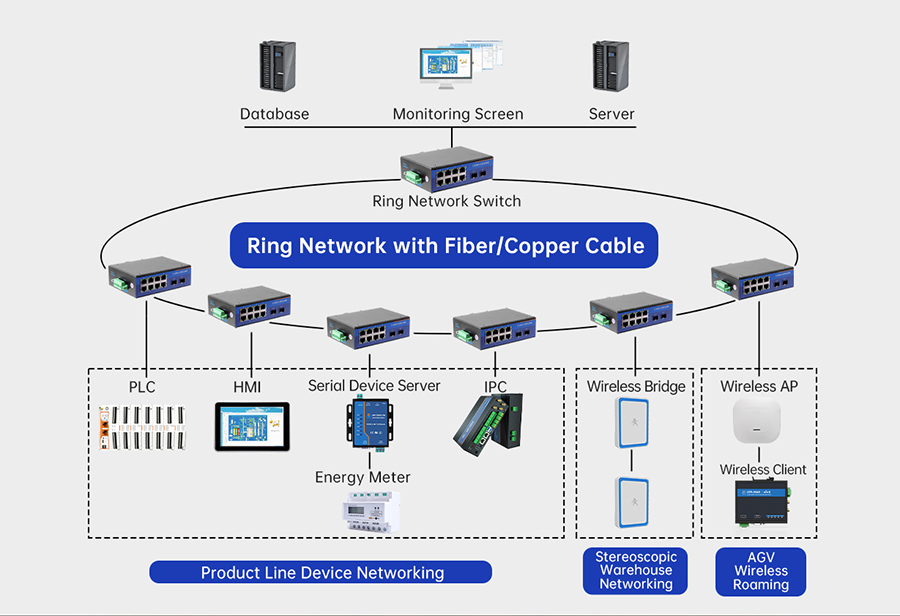
Industrial sites feature a variety of different devices and protocols, such as Modbus TCP, PROFINET, EtherNet/IP, etc. Industrial switches, through their built-in protocol conversion engines, can simultaneously handle over 10 industrial protocols, enabling seamless communication between different devices.
For example, in a smart factory, there may be Siemens PLCs from Germany, Fanuc robots from Japan, and domestically produced sensors. Industrial switches can connect these devices of different brands and protocols together, constructing a unified communication network.
Additionally, the application of OPC UA over TSN technology allows for standardized processing of device data at the switch level, further enhancing interoperability between devices.
New-generation industrial switches are beginning to integrate lightweight AI inference modules, possessing edge computing capabilities. In a practice at a smart factory in Germany, industrial switches equipped with edge computing functions achieved local data preprocessing and real-time anomaly detection. They can filter out over 90% of invalid data, reducing core network bandwidth requirements by 70%. Simultaneously, through machine learning models, they identify equipment vibration characteristics, shortening fault warning times from hours to minutes. This not only improves data processing efficiency but also reduces reliance on cloud servers, enhancing system real-time performance and reliability.
The core technologies of industrial switches serve as a solid foundation, supporting their outstanding performance in complex industrial environments. High-speed and precise data exchange technologies enable instant transmission of vast amounts of industrial information; strong anti-interference capabilities ensure stable and error-free signal transmission in strong electromagnetic environments; and intelligent redundancy designs guarantee uninterrupted network operation in the event of sudden failures.
When we focus our attention, we find that these core technologies do not exist in isolation. They are closely intertwined and operate in synergy, jointly constructing the core architecture of industrial switches.
Core Functions: Packet forwarding, L2/L3 protocol processing (STP/OSPF), and support for industrial protocols (Modbus TCP/PROFINET).
Key Technologies: Hardware pipeline (microsecond-level latency), TSN (deterministic transmission), and TCAM acceleration (ACL/QoS matching).
Types:
Electrical ports (RJ45): 10/100/1000Mbps, connecting PLCs and computers;
Optical ports (SFP/SFP+): 10G/40G, enabling long-distance fiber-optic transmission;
PoE ports: Combining power supply and data transmission (e.g., for IP cameras);
Redundancy design: Link aggregation (LACP) with 50ms failure switching.
Redundant power supply: AC/DC dual power modules with seamless main-backup switching;
Wide voltage support: AC 100-240V (universal) or DC 12/24/48V (for special scenarios).
Protection rating: IP40 (dust and water resistance), with some models rated IP67 (water immersion capable);
Shock resistance: DIN rail mounting for vibration-prone environments;
Heat dissipation methods: Fanless (metal casing for heat dissipation) or low-noise fans.
Real-time kernel: RTOS or customized scheduling algorithms to ensure low latency (≤10μs);
Protocol support: L2/L3 protocols (STP/OSPF) + industrial protocols (EtherNet/IP);
TSN integration: Time synchronization (IEEE 802.1AS) + traffic scheduling (IEEE 802.1Qbv).
Web interface: Graphical configuration (VLAN/QoS);
CLI command line: SSH/Telnet remote management;
SNMP/NETCONF: Integration into network management platforms (e.g., SolarWinds).
Access control: ACL rules + 802.1X authentication;
Data encryption: MACsec (link layer) + IPsec (network layer);
Protocol protection: ARP spoofing prevention, DHCP Snooping.
P4 programming: Custom forwarding logic (e.g., protocol parsing);
AI integration: Local data preprocessing (e.g., equipment vibration analysis);
Containerization: Splitting functions into independent containers (routing/monitoring) for easy upgrades.
Hardware acceleration: Switching chips handle ACL/QoS, freeing up CPU resources;
Low latency: Real-time kernel + hardware pipeline for microsecond-level control command response;
High reliability: Redundant power/ports + ring network protocols (ERPS), with an MTBF exceeding 200,000 hours;
Environmental adaptability: Wide temperature range (-40°C to 85°C), dust and water resistance, and vibration resistance, meeting the demands of industrial scenarios.
Industrial switches feature a precisely designed traffic network to achieve seamless interconnection and stable communication between devices in practical application scenarios, supporting the practical outcomes of various settings.
Leveraging their high reliability, environmental adaptability, and intelligent network management capabilities, industrial switches have established unique application advantages in the Industrial Internet of Things (IIoT). Their typical application solutions cover a range of scenarios with stringent requirements for network stability, real-time performance, and security. The following are specific solutions and analyses:
In automated production lines such as automotive manufacturing and electronic assembly, PLCs, sensors, robots, and other devices need to interact with data in real time. Ordinary switches are prone to causing asynchronous device actions due to protocol incompatibility and latency fluctuations, leading to production accidents.
Industrial Switch Solutions:
● Protocol Parsing and Scheduling: Support industrial protocols such as Modbus TCP, PROFINET, and EtherCAT, parsing instruction content and optimizing transmission paths. For example, Tesla's Gigafactory uses industrial switches to synchronize welding parameters, component assembly sequences, and other data to robots in real time, ensuring that production errors for each vehicle are controlled within millimeters.
● Low Latency and High Bandwidth: Utilize optimized backplane bandwidth and packet forwarding rate designs to meet the demands of large data volume transmission. In semiconductor manufacturing, industrial switches support real-time control of nanometer-precision equipment, preventing wafer scrap due to network latency.
● Redundancy Design: Ensure 7x24-hour production line operation through ERPS ring network redundancy protocols (link recovery time ≤ 50ms) and dual power redundancy. After switching to industrial switches, a certain automotive factory reduced annual downtime from 20 hours to 0.5 hours, improving production efficiency by 18%.
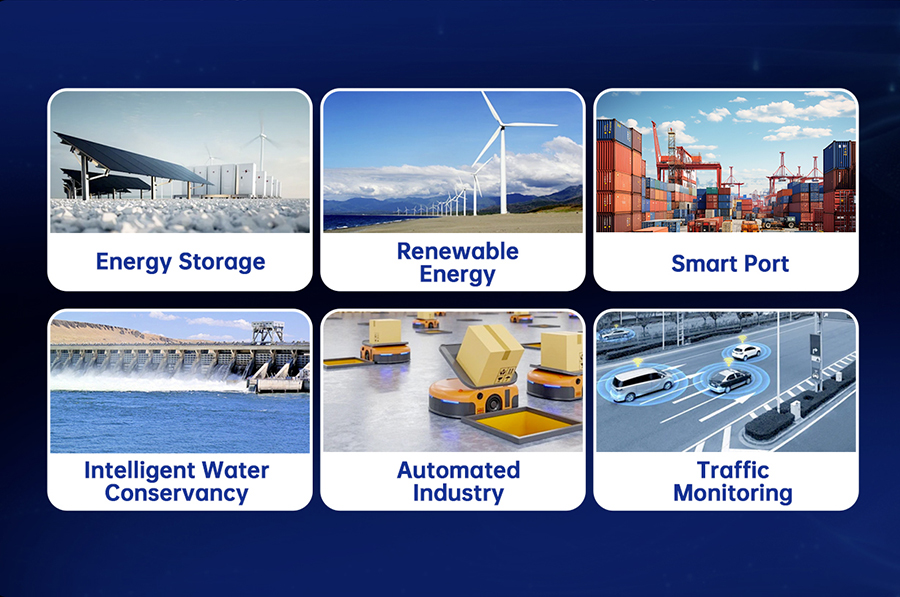
Power plants, power grids, wind farms, and other scenarios are subject to strong electromagnetic interference and extreme temperatures (high/low). Ordinary switches are prone to data interruptions due to power failures or signal interference, affecting the safety of power dispatch.
Industrial Switch Solutions:
● Electromagnetic Interference Resistance and Wide Temperature Design: Adopt EMC Level 4 electromagnetic compatibility to adapt to the strong electromagnetic environment of substations; operate within a temperature range of -40°C to 85°C, meeting the extreme climate needs of photovoltaic power stations in Xinjiang and wind farms in Northeast China. For example, the Three Gorges Hydropower Station uses industrial switches to transmit water levels, power generation, and other data to the control center in real time, ensuring the stable operation of the power system.
● Ring Network Redundancy and High Reliability: Support Spanning Tree Protocol (802.1s MSTP) and fast ring network technology, with data link recovery times as fast as 20ms. In the auxiliary control system of thermal power plants, industrial switches connect decentralized control points such as water networks, coal networks, and ash networks, enabling redundant communication between the main control room and protection systems, excitation systems, and avoiding full-plant shutdowns due to single-point failures.
● Long-Distance Transmission Support: Integrate optical fiber ports to meet the long-distance data transmission needs of wind farms, photovoltaic power stations, and other scenarios. A certain offshore wind farm uses industrial switches to transmit wind turbine vibration data and power parameters back to the onshore monitoring center in real time, shortening fault warning response times to seconds.
Scenarios such as subways, high-speed railways, and highways are subject to high-intensity vibration, impact, and complex electromagnetic environments. Ordinary switches are prone to traffic signal control failures and monitoring data loss due to mechanical failures or signal interference.
Industrial Switch Solutions:
● High Protection Level and Shock Resistance: Adopt IP67 protection level (dustproof and waterproof) and 6KV lightning protection to adapt to the harsh conditions of subway tunnels and outdoor highway environments. For example, Beijing Subway uses industrial switches to connect the Passenger Information System (PIS), Automatic Fare Collection (AFC) system, and Integrated Supervisory Control System (ISCS), ensuring real-time transmission of train operation status and passenger flow data.
● Real-Time Performance and Low Jitter: Support TSN (Time-Sensitive Networking) technology, providing microsecond-level clock synchronization and low-latency transmission to meet the real-time requirements of high-speed railway signal control and train marshalling scenarios. On the Beijing-Zhangjiakou High-Speed Railway, industrial switches synchronize train position and speed data to the dispatch center, ensuring precise train intervals down to seconds.
● POE Power Supply and Simplified Wiring: Industrial POE switches can power IP cameras, sensors, and other devices, reducing the cost of power line installation. In highway electromechanical systems, industrial switches connect the toll collection, monitoring, and communication systems through optical fiber ring networks, enabling efficient data interchange across the entire road section.
Meteorological stations, water quality monitoring stations, and other scenarios are widely distributed and require long-term outdoor operation. Ordinary switches are prone to equipment failures due to dust and humidity, affecting the continuity of data collection.
Industrial Switch Solutions:
● Fanless Design and Dust/Water Resistance: Utilize metal casing for heat dissipation, reducing dust ingress; IP40 and above protection levels adapt to sandy, rainy, and snowy environments. For example, the Qinghai Meteorological Bureau uses industrial switches to connect wind speed and humidity sensors, achieving continuous data collection for over 5 years in harsh environments such as the Gobi Desert.
● Remote Monitoring and Management: Support SNMP, Web management, and other functions to remotely view device status and configure parameters, reducing on-site maintenance costs. In water quality monitoring, industrial switches transmit pH, dissolved oxygen, and other data to environmental protection departments in real time, aiding pollution warning and treatment.
● Multi-Protocol Support and Extensibility: Compatible with protocols such as Modbus and OPC UA, enabling connection to monitoring equipment from different manufacturers. A certain chemical park uses industrial switches to integrate gas concentration, temperature, and other data, building a unified environmental monitoring platform and improving emergency response speed.
In the precision production lines of industrial automation, the wide-area networks of energy monitoring, the real-time scheduling of intelligent transportation, and the distributed nodes of environmental monitoring, industrial switches serve as "data hubs." With features such as high-reliability ring networks, anti-interference designs, and wide-temperature operation, they weave decentralized terminal devices into intelligent collaborative networks. As technical solutions transition from blueprints to implementation, the key to elevating intelligent systems from "usable" to "user-friendly" lies in matching these "data hubs" with the most suitable hardware configurations based on the bandwidth requirements, installation space, protocol compatibility, and other characteristics of different scenarios.
Industrial environments experience significant temperature variations. Industrial switches can typically operate normally within a wide temperature range of -40°C to 75°C. Whether it's the extremely cold outdoor environment in northern winters or the hot interior of factories in southern summers, they can run stably, ensuring the continuity of industrial production.
● High Protection Ratings:They possess high protection ratings (such as IP40, IP65, IP67, etc.), effectively preventing dust, water droplets, oil stains, etc., from entering the device and causing damage to the circuitry. For example, they can reliably operate in dusty environments like mines and cement plants, as well as in damp settings such as food processing and chemical plants.
● Electromagnetic Interference Resistance:Industrial sites are filled with numerous electromagnetic interference sources, such as motors, frequency converters, and welding machines. Industrial switches employ special shielding designs and electromagnetic compatibility technologies to effectively resist electromagnetic interference, ensuring the stability and accuracy of data transmission and preventing data errors or communication interruptions caused by interference.
● Shock and Impact Resistance: In some industrial scenarios, equipment may be subjected to vibrations and impacts, such as in rail transit and shipping. Industrial switches have excellent shock and impact resistance, utilizing reinforced designs and shock-absorbing materials to operate normally in vibrating and impact-prone environments, ensuring network reliability.
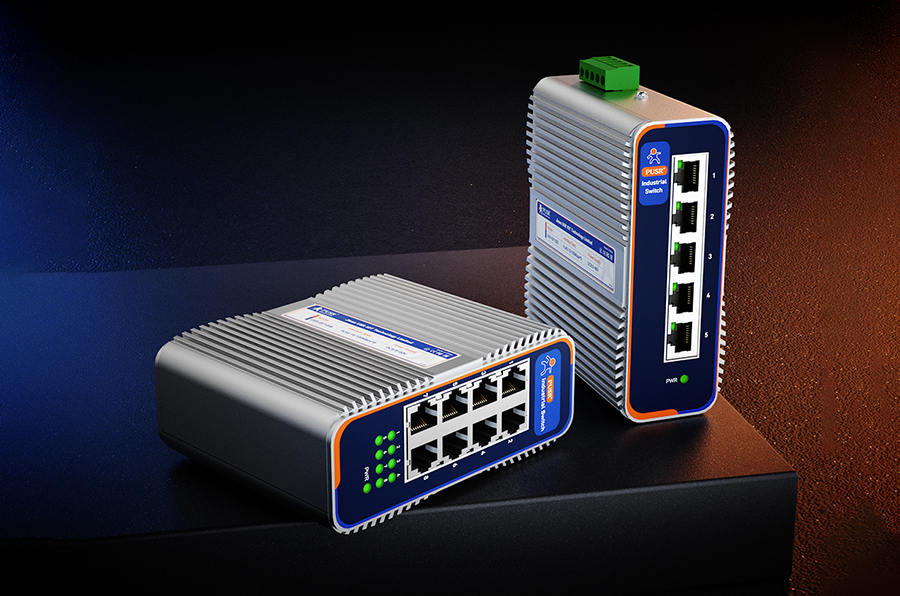
They support functions such as power redundancy and link redundancy. Power redundancy provides dual power inputs. When one power source fails, the other can immediately take over, ensuring continuous power supply to the device. Link redundancy, through topologies like ring and dual-link, allows data to automatically switch to a backup link for transmission when a certain link fails, enabling rapid network self-healing and significantly improving network reliability.
● Industrial-Grade Components:Industrial-grade chips, capacitors, resistors, and other components are selected. These components offer higher reliability and stability, enabling long-term use in harsh industrial environments, reducing the probability of equipment failures, and lowering maintenance costs.
● Long Lifespan Design: Industrial switches are usually designed with a long lifespan, typically lasting over 10 years. They are made of high-quality materials and crafted with exquisite techniques, undergoing strict quality inspections and reliability tests to ensure stable performance during long-term operation, reducing the frequency and cost of equipment replacement.
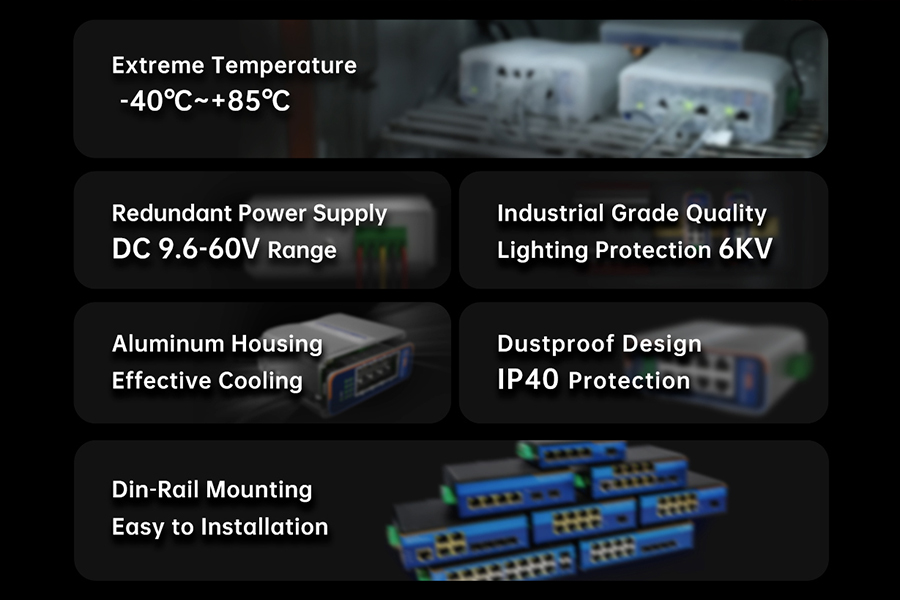
They can be compatible with and support various industrial communication protocols, such as Modbus TCP, Profinet, EtherCAT, and DeviceNet, facilitating connection and communication with various industrial equipment, achieving interconnection and data sharing among devices, and providing strong support for the integration and collaborative operation of industrial automation systems.
● Strong Real-Time Performance:In the field of industrial control, high real-time requirements are placed on data. Industrial switches employ real-time operating systems and optimized data forwarding algorithms, enabling rapid data processing and forwarding to ensure the timely and accurate transmission of control commands and sensor data, meeting the strict real-time requirements of industrial production processes.
● Precise Clock Synchronization: They support precise clock synchronization protocols (such as IEEE 1588), achieving precise time synchronization between switches and industrial equipment with accuracy up to the microsecond or even nanosecond level. This is of great significance for applications requiring high-precision time synchronization, such as distributed control systems and motion control.
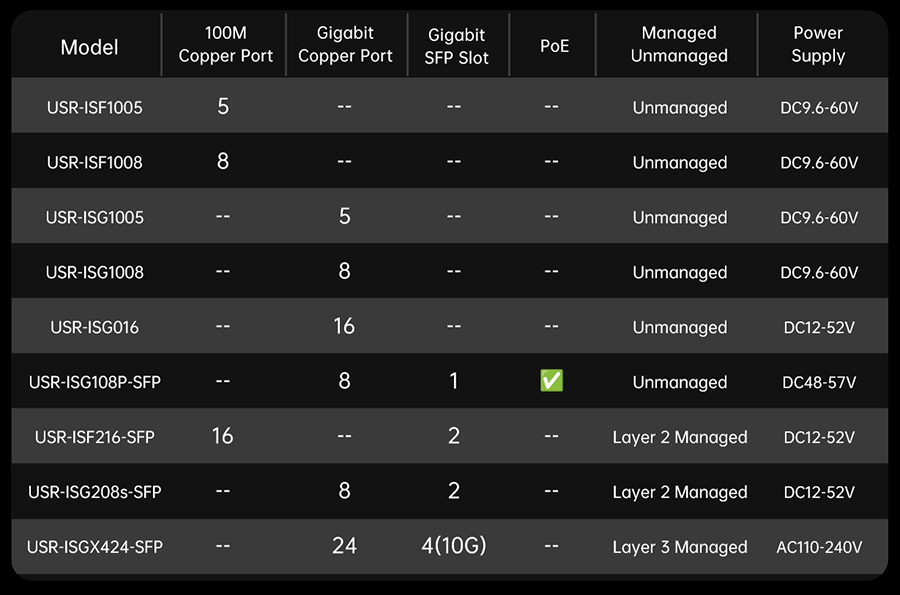
They provide various management interfaces and methods, such as Web interfaces, SNMP, Telnet, and CLI, facilitating remote configuration, monitoring, and management of switches by administrators. Through the Web interface, administrators can visually view the operating status, port information, and traffic statistics of the switches and perform corresponding configuration operations. The SNMP protocol enables centralized management and monitoring of switches, improving management efficiency.
● Fault Diagnosis and Early Warning:They feature comprehensive fault diagnosis and early warning functions, capable of real-time monitoring of device operating status and network traffic. When abnormalities are detected, such as port failures, link interruptions, or traffic overloads, they can promptly issue alarm messages to notify administrators for handling. At the same time, they can provide detailed fault logs and diagnostic information to help administrators quickly locate and resolve faults.
● Convenient Firmware Upgrades:They support remote firmware upgrade functions, allowing administrators to upgrade the firmware of switches over the network without the need for on-site operations. Firmware upgrades can fix vulnerabilities in devices, add new functional features, and improve device performance and security.
In the future, industrial switches will deeply integrate artificial intelligence and big data technologies. With the help of AI algorithms, they will be able to perform self-diagnosis and intelligent optimization, predict faults in advance, and automatically adjust parameters, significantly improving operation and maintenance efficiency. Driven by 5G and the industrial Internet, they will feature higher bandwidth and lower latency to meet the real-time communication needs of large-scale equipment, facilitating remote control and collaborative manufacturing.
At the same time, the concept of green energy conservation will permeate their development. By adopting low-power chips and intelligent sleep technologies, energy consumption will be reduced. Moreover, to adapt to complex and ever-changing industrial scenarios, the protection ratings and reliability of industrial switches will be further enhanced, enabling stable operation in harsh environments such as extreme temperatures and strong electromagnetic interference, thus providing more solid communication guarantees for the development of industrial intelligence.
Looking ahead to the future of industrial switches, they will be deeply integrated with cutting-edge technologies such as artificial intelligence and 5G, achieving leaps in performance and intelligence levels and laying a solid foundation for the development of the industrial Internet. However, with a wide array of products available in the market, selecting the right model becomes crucial. Appropriate selection requires a comprehensive consideration of multiple factors, ensuring that it not only meets the current industrial scenario requirements but also leaves room for future upgrades. Only in this way can industrial switches fully unleash their potential and contribute to the efficient and stable operation of industrial production.